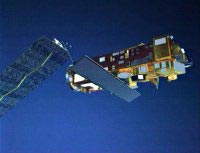Envisat prepares to start work

Envisat’s ASAR fully deployed
Since its successful launch into sun synchronous orbit on the morning of the first of March, Envisat has been getting ready to start observing the Earth.
Its 70 m2 of solar arrays are fully deployed, thus enabling it to obtain power from the Sun, and the ASAR antenna is now extending to its full 10 m, ready for its deployment in space. This will bring to an end the Launch and Early Orbit Phase.
The next step is the Switch on and Data Acquisition Phase that starts today. One by one, each of the 10 instruments on board will be turned on during the next few days, the instruments calibrated and a first verification of the data carried out. These activities are essential to guarantee the quality of the data that ESA will provide to Envisat users.
This phase will involve more than 200 people, including ESA staff and scientists all over the world, and entail the use of ground calibrators, ships, buoys, planes or balloons. As soon as the calibration and validation activities are completed, the delivery of data to Envisat users will start, a process expected to commence in September this year.
Tonight it is the turn of the Ka-band antenna to be released. This antenna will be used to transmit data, via Artemis, to a ground station located at ESA/ESRIN in Frascati, Italy, to ensure that data will arrive in near-real time.
Would you like to know more about how the data supplied by the 10 state-of-the-art instruments on board Envisat will help to protect the Earth and how the instruments work? Do you know exactly where Envisat is at present?
Our new site Envisat Expected Results contains text, photos and videos. All this information should help to answer your questions as well as explain why scientists all over the world are eagerly awaiting the data that Envisat, ESA’s new Earth observation satellite, will soon provide.
Media Contact
All latest news from the category: Earth Sciences
Earth Sciences (also referred to as Geosciences), which deals with basic issues surrounding our planet, plays a vital role in the area of energy and raw materials supply.
Earth Sciences comprises subjects such as geology, geography, geological informatics, paleontology, mineralogy, petrography, crystallography, geophysics, geodesy, glaciology, cartography, photogrammetry, meteorology and seismology, early-warning systems, earthquake research and polar research.
Newest articles

How Geothermal Energy Shapes Bavaria’s Green Future Through Sustainable Energy
The Bavarian State Ministry of Science and the Arts has extended its funding for the research association “Geothermal Alliance Bavaria,” with the University of Bayreuth (UBT) continuing as a member…

Spintronics memory innovation: A new perpendicular magnetized film
Long gone are the days where all our data could fit on a two-megabyte floppy disk. In today’s information-based society, the increasing volume of information being handled demands that we…

Materials with a ‘twist’ show unexpected electronic behaviour
In the search for new materials that can enable more efficient electronics, scientists are exploring so-called 2-D materials. These are sheets of just one atom thick, that may have all…



